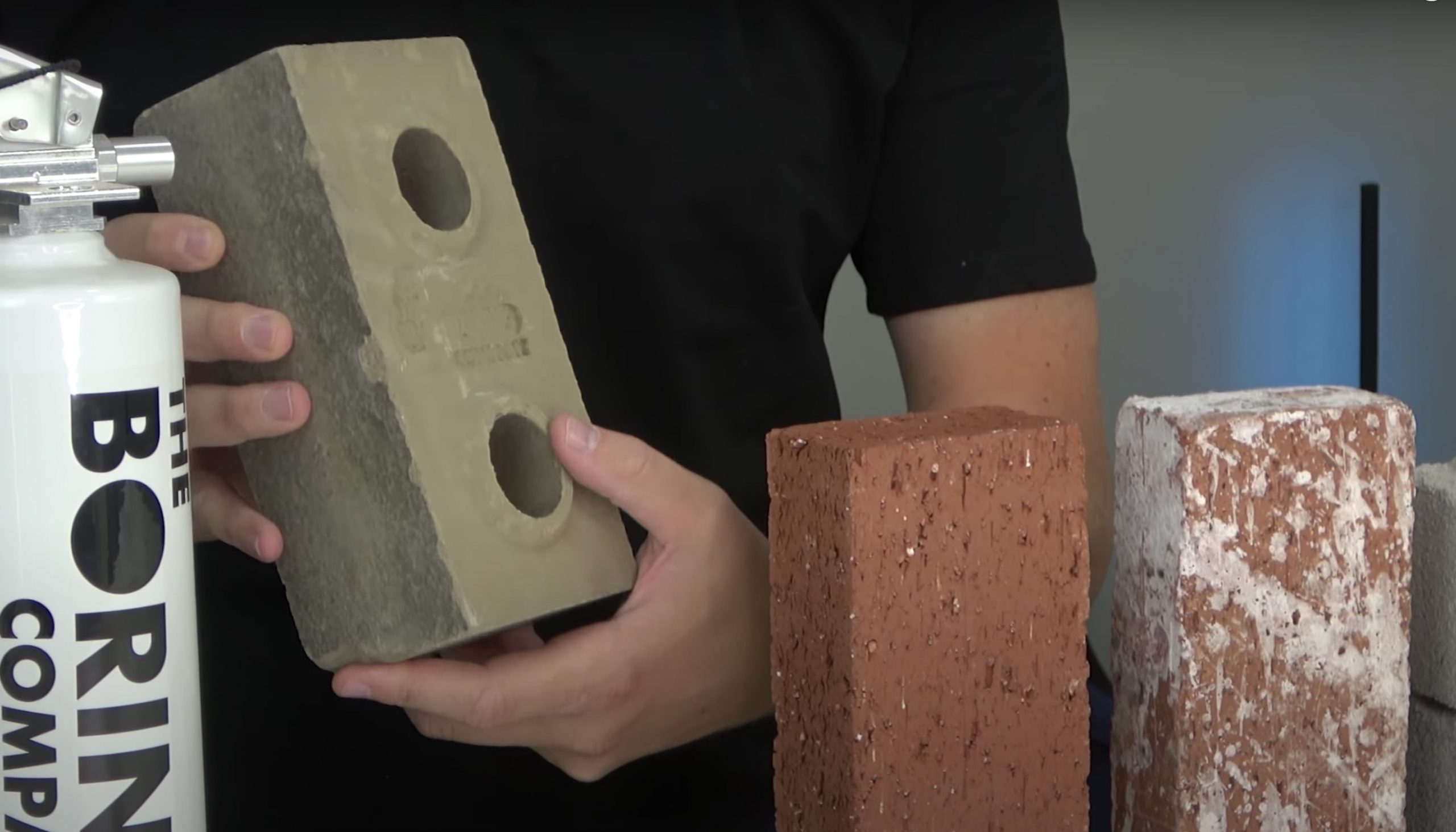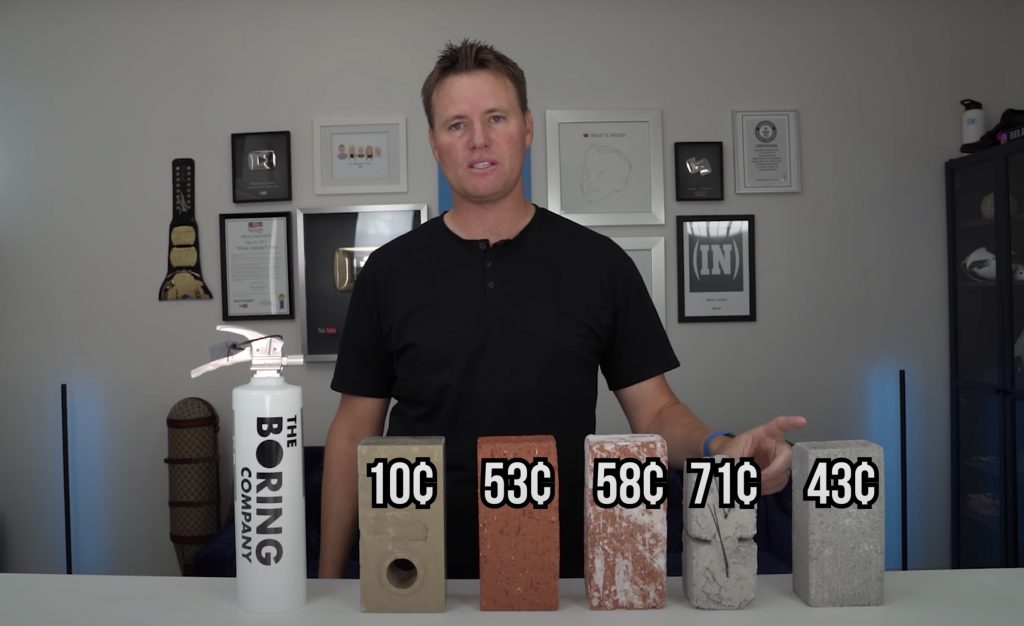

News
Tesla owner scores Elon Musk’s “V1” Boring Brick to perform drop test comparison
A Tesla owner recently acquired a rare “V1” sample of Elon Musk’s Boring Company brick for a durability test. Dan Markham from YouTube’s What’s Inside channel was able to get his hands on two Boring bricks and had some fun performing a drop test to compare its durability with potential competitors in the market.
Markham managed to get a hold of two Boring Bricks from the first batch of 500 “V1” pieces, thanks to a Boring Co. employee. The Tesla and SpaceX CEO has talked about inexpensive bricks made out of tunneling rock since 2018, and in true Elon Musk fashion, he called them Boring Bricks. Musk had stated that the Boring Bricks would cost 10¢ a piece, significantly lower than bricks on the market.
Besides the Boring Brick’s material and affordable price, another intriguing feature about it would be its durability. When Musk introduced the Boring Brick, he emphasized its strength. “[Boring Bricks are] Rated for California seismic loads, so super strong, but bored in the middle, like an aircraft wing spar, so not heavy,” Musk said later in a tweet.
Markham wanted to put Musk’s words to the test and compared his Boring Bricks with four traditional alternatives. He bought an average red clay brick for 53¢, a used clay brick for 58¢, a cinder block brick reinforced with steel for 71¢, and a normal cinder block brick for 43¢.

For his durability test, Markham dropped each brick from different heights until they broke into pieces. For the first test, he dropped them from chest-level and the Boring Brick passed with no problem. The 71¢ cinder block brick reinforced with steel passed without any scratches, and the 53¢ red clay brick survived the first test as well with a slight chip in the corner.
Sadly, the 58¢ clay brick and 43¢ cinder block were eliminated in the first round after both broke in two.
For the second test, Markem went up a flight of stairs and dropped the bricks from about 10 feet above the ground. The remaining bricks all passed the second round relatively unscathed, except for a small chip on the corner of the red clay brick and a tiny one on the Boring Brick.
In the third test, the Boring Brick proved its durability once more, surviving a fall from about 12-14 feet above the ground with just another slight chip. By this time, the only other brick that survived Markham’s durability test was the cinder block brick reinforced with steel, which cost over 7x the price of the Boring Brick.
The What’s Inside? host’s test was undoubtedly fun and did demonstrate the durability of the Boring Brick at some level. However, the durability of bricks is usually tested through compression and there are other factors to consider when judging a brick’s quality.
Nevertheless, Markham’s video managed to show that the Boring Brick is a viable product and could be another potentially revolutionary idea from Musk. At its price point, Boring Bricks could change the construction and housing market. Markham paid a little extra for his Boring Bricks but didn’t seem to mind since they were commemorative pieces. He paid $200 for each Boring Brick and gave one of them to a friend.
Elon described Boring Bricks as “lifesize LEGO-like interlocking bricks” in the past. Based on the bricks that Markham acquired, it appears that Musk is sticking to his plan. The Boring Brick had two holes in the center reminiscent of Lego bricks, with “The Boring Company” written in the middle. These should allow for easy buildouts for construction projects, as the bricks are optimized to be laid with relatively little effort.
Watch Dan Markham’s Boring Brick durability test in the video below.

News
Tesla (TSLA) receives “Buy” rating and $551 PT from Canaccord Genuity
He also maintained a “Buy” rating for TSLA stock over the company’s improving long-term outlook, which is driven by autonomy and robotics.

Canaccord Genuity analyst George Gianarikas raised his Tesla (NASDAQ:TSLA) price target from $482 to $551. He also maintained a “Buy” rating for TSLA stock over the company’s improving long-term outlook, which is driven by autonomy and robotics.
The analyst’s updated note
Gianarikas lowered his 4Q25 delivery estimates but pointed to several positive factors in the Tesla story. He noted that EV adoption in emerging markets is gaining pace, and progress in FSD and the Robotaxi rollout in 2026 represent major upside drivers. Further progress in the Optimus program next year could also add more momentum for the electric vehicle maker.
“Overall, yes, 4Q25 delivery expectations are being revised lower. However, the reset in the US EV market is laying the groundwork for a more durable and attractive long-term demand environment.
“At the same time, EV penetration in emerging markets is accelerating, reinforcing Tesla’s potential multi‑year growth runway beyond the US. Global progress in FSD and the anticipated rollout of a larger robotaxi fleet in 2026 are increasingly important components of the Tesla equity story and could provide sentiment tailwinds,” the analyst wrote.
Tesla’s busy 2026
The upcoming year would be a busy one for Tesla, considering the company’s plans and targets. The autonomous two-seat Cybercab has been confirmed to start production sometime in Q2 2026, as per Elon Musk during the 2025 Annual Shareholder Meeting.
Apart from this, Tesla is also expected to unveil the next-generation Roadster on April 1, 2026. Tesla is also expected to start high-volume production of the Tesla Semi in Nevada next year.
Apart from vehicle launches, Tesla has expressed its intentions to significantly ramp the rollout of FSD to several regions worldwide, such as Europe. Plans are also underway to launch more Robotaxi networks in several more key areas across the United States.
News
Waymo sues Santa Monica over order to halt overnight charging sessions
In its complaint, Waymo argued that its self-driving cars’ operations do not constitute a public nuisance, and compliance with the city’s order would cause the company irreparable harm.

Waymo has filed a lawsuit against the City of Santa Monica in Los Angeles County Superior Court, seeking to block an order that requires the company to cease overnight charging at two facilities.
In its complaint, Waymo argued that its self-driving cars’ operations do not constitute a public nuisance, and compliance with the city’s order would cause the company irreparable harm.
Nuisance claims
As noted in a report from the Los Angeles Times, Waymo’s two charging sites at Euclid Street and Broadway have operated for about a year, supporting the company’s growing fleet with round-the-clock activity. Unfortunately, this has also resulted in residents in the area reportedly being unable to sleep due to incessant beeping from self-driving taxis that are moving in and out of the charging stations around the clock.
Frustrated residents have protested against the Waymos by blocking the vehicles’ paths, placing cones, and “stacking” cars to create backups. This has also resulted in multiple calls to the police.
Last month, the city issued an order to Waymo and its charging partner, Voltera, to cease overnight operations at the charging locations, stating that the self-driving vehicles’ activities at night were a public nuisance. A December 15 meeting yielded no agreement on mitigations like software rerouting. Waymo proposed changes, but the city reportedly insisted that nothing would satisfy the irate residents.
“We are disappointed that the City has chosen an adversarial path over a collaborative one. The City’s position has been to insist that no actions taken or proposed by Waymo would satisfy the complaining neighbors and therefore must be deemed insufficient,” a Waymo spokesperson stated.
Waymo pushes back
In its legal complaint, Waymo stated that its “activities at the Broadway Facilities do not constitute a public nuisance.” The company also noted that it “faces imminent and irreparable harm to its operations, employees, and customers” from the city’s order. The suit also stated that the city was fully aware that the Voltera charging sites would be operating around the clock to support Waymo’s self-driving taxis.
The company highlighted over one million trips in Santa Monica since launch, with more than 50,000 rides starting or ending there in November alone. Waymo also criticized the city for adopting a contentious strategy against businesses.
“The City of Santa Monica’s recent actions are inconsistent with its stated goal of attracting investment. At a time when the City faces a serious fiscal crisis, officials are choosing to obstruct properly permitted investment rather than fostering a ‘ready for business’ environment,” Waymo stated.
News
Tesla FSD v14.2.2 is getting rave reviews from drivers
So far, early testers have reported buttery-smooth drives with confident performance, even at night or on twisty roads.

Tesla Full Self-Driving (Supervised) v14.2.2 is receiving positive reviews from owners, with several drivers praising the build’s lack of hesitation during lane changes and its smoother decision-making, among others.
The update, which started rolling out on Monday, also adds features like dynamic arrival pin adjustment. So far, early testers have reported buttery-smooth drives with confident performance, even at night or on twisty roads.
Owners highlight major improvements
Longtime Tesla owner and FSD user @BLKMDL3 shared a detailed 10-hour impression of FSD v14.2.2, noting that the system exhibited “zero lane change hesitation” and “extremely refined” lane choices. He praised Mad Max mode’s performance, stellar parking in locations including ticket dispensers, and impressive canyon runs even in dark conditions.
Fellow FSD user Dan Burkland reported an hour of FSD v14.2.2’s nighttime driving with “zero hesitations” and “buttery smooth” confidence reminiscent of Robotaxi rides in areas such as Austin, Texas. Veteran FSD user Whole Mars Catalog also demonstrated voice navigation via Grok, while Tesla owner Devin Olsen completed a nearly two-hour drive with FSD v14.2.2 in heavy traffic and rain with strong performance.
Closer to unsupervised
FSD has been receiving rave reviews, even from Tesla’s competitors. Xpeng CEO He Xiaopeng, for one, offered fresh praise for FSD v14.2 after visiting Silicon Valley. Following extended test drives of Tesla vehicles running the latest FSD software, He stated that the system has made major strides, reinforcing his view that Tesla’s approach to autonomy is indeed the proper path towards autonomy.
According to He, Tesla’s FSD has evolved from a smooth Level 2 advanced driver assistance system into what he described as a “near-Level 4” experience in terms of capabilities. While acknowledging that areas of improvement are still present, the Xpeng CEO stated that FSD’s current iteration significantly surpasses last year’s capabilities. He also reiterated his belief that Tesla’s strategy of using the same autonomous software and hardware architecture across private vehicles and robotaxis is the right long-term approach, as it would allow users to bypass intermediate autonomy stages and move closer to Level 4 functionality.








